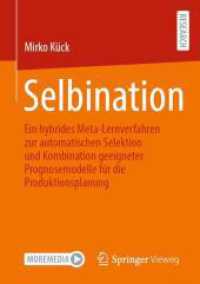- ホーム
- > 洋書
- > ドイツ書
- > Humanities, Arts & Music
- > Music
Description
(Text)
Universal Edition steht für einen neuen Standard im Bereich der Studienpartituren. Die komplett neu gestalteten Partituren bieten einen beispiellosen Einblick in die Musik der letzten hundert Jahre. Es wird sorgfältig darauf geachtet, stets den besten verfügbaren Inhalt für diese Reise durch die Musikgeschichte auszuwählen. Jede Partitur wird zudem nach den neuesten Qualitätsstandards ediert.Die Neue Studienpartituren Reihe kombiniert historische Meisterwerke mit erstklassigen redaktionellen Inhalten, Vorworten und einer gut lesbaren, klaren Notation in der bewährten Universal Edition-Qualität.
(Table of content)
1. Satz · 2. Satz · 3. Satz
(Text)
Kurt Weill developed his creative energies mainly within the world of musical theater, where he proved to be an immensely productive and imaginative innovator, but he also left behind a small body of work for the concert hall. The Concerto for Violin and Wind Orchestra op. 12 dates from the spring of 1924. Scored for two flutes, clarinets, bassoons, horns, one oboe and trumpet, percussion and four contrabasses, the concerto comprises three movements. While composing the work, Weill informed his publisher: 'I am working on a concerto for violin and wind orchestra that I hope to finish within two or three weeks. The work is inspired by the idea - one never carried out before - of juxtaposing a single violin with a chorus of winds.'
The specific character of Weill's concerto as music written for chamber orchestra (with an often soloistic treatment of instruments) leads to a transparency that requires utmost precision in the ensemble playing. In the quest for an overall sonic balance, the coarser-sounding wind instruments need to explore all dynamic nuances. The solo part is challenging not only from a technical standpoint but also from an acoustic one (it is crucial to make the violin 'sound'). In spite of these challenges - or precisely because of them - critics in the 1920s called the solo part highly idiomatic and extremely rewarding. Since then the concerto has become a 'modern classic' in concert halls around the world. (Elmar Juchem, August 2010)Instrumentation:for violin and wind orchestraop. 12nce, the coarser-sounding wind instruments need to explore all dynamic nuances. The solo part is challenging not only from a technical standpoint but also from an acoustic one (it is crucial to make the violin 'sound'). In spite of these challenges - or precisely because of them - critics in the 1920s called the solo part highly idiomatic and extremely rewarding. Since then the concerto has become a 'modern classic' in concert halls around the world. (Elmar Juchem, August 2010)Instrumentation:for violin and wind orchestraop. 12








